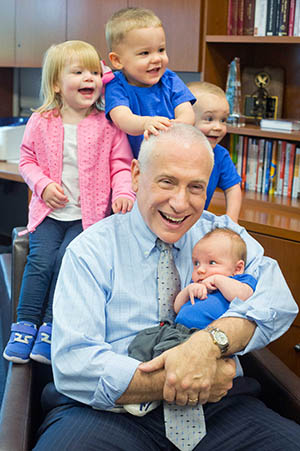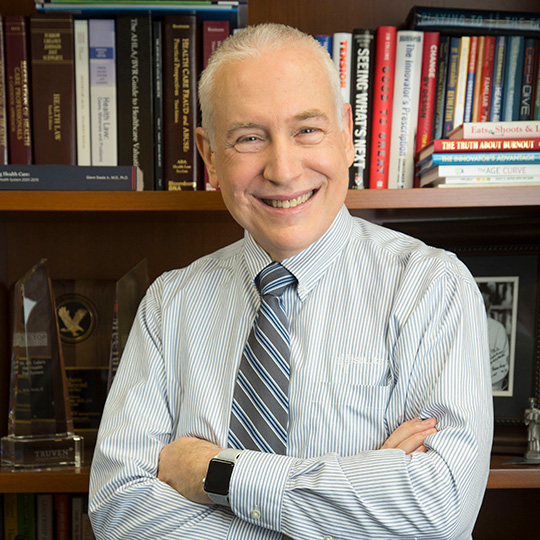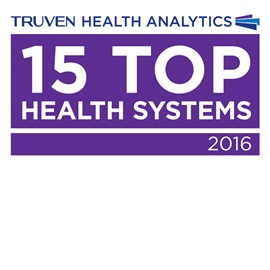Dr. Pate’s Prescription for Change
Lessons for Educators from Health Care and St. Luke’s CEO Dr. David Pate


Editor’s note – This blog post is based on an interview with Jennifer Swindell for an article she wrote, “CEO Shares His Thoughts on Improving Idaho Education,” for idahoednews.org.
I don’t pretend to have any expertise in the field of education, but years ago, I heard Dr. Bob Kustra, president of Boise State, give a talk on the challenges facing higher education. I was struck by the similarities with the challenges facing health care.
Later, I wondered whether some of the lessons I have learned in leading a healthcare organization through the transformation of our industry might have relevance to educators trying to transform their own industry, and whether learning from my experiences might help expedite their own journey.
For me, the journey begins with an acknowledgement that our industry is flawed – it is inconsistent in its quality, far too unsafe and for far too many, unaffordable. Might education be inconsistent in its quality and too expensive?
Until we can acknowledge that we have a problem, we are unlikely to solve it. When I interviewed for my current position, in May of 2009, I had done my homework. I realized before meeting with the St. Luke’s Health System search committee that there was tremendous inter- and intra-hospital variation in quality.
Though the board believed that they were the quality leader in the market at the time, they were not. I remember telling the search committee that if they selected me, I hoped to make them as good within three years as they thought they were.
I am very proud to say today that not only are we indisputably the quality leader in our market, we have received national acclaim as one of the top 15 health systems in the country, and numerous recognitions and awards from every public rating agency of which I am aware. Now, we are trying to make health care more affordable.
Here’s what I have learned.
Be self-critical.
What do you think would happen if I asked all the school principals or superintendents across the country to rate their school or district and their own leadership and gave as choices the: (a) top decile; (b) top quartile; (c) top half; (d) third quartile; (e) bottom quartile; or (f) bottom decile? How many do you suppose would rate themselves in the top decile, keeping in mind that only 10 percent can be in the top decile?
When I was in medical practice in Houston, I would have told you that I was the best general internist in town.
Why? There were no measures of quality for physicians at the time and no data. And in the absence of data, everyone believes they are the best.
Back to the survey above; my guess is that at least 90 percent of respondents would rate themselves and their schools in the top decile. And without objective quality measures, data regarding performance against those measures and access to that information, principals and superintendents are likely to believe they are among the best.
What is the harm in that? Complacency. Complacency must be the enemy of any leader and any organization truly seeking excellence and trying to transform the industry. If we are already among the best, what is the sense of urgency, the need for change that will drive transformative work? How can you possibly get others to change if you cannot give a compelling reason for the need?
Welcome data, even when it doesn’t reflect positively on you or your organization.
I saw early on that when I would show a physician (and remember, physicians are scientists) data that portrayed themselves, their service, or their hospital in less than favorable light, they would immediately come up with a list of reasons as to why the study or data were flawed and they would dismiss it.
I am not saying that they sat down with the data, examined the methodology and then identified a flaw or limitation; rather, they immediately came up with reasons that the data did not apply to them or why the study could not be trusted. Yet when I presented physicians with data that portrayed them, their service or the hospital in a favorable light, they accepted the data as valid, again without any critical exploration.
My key points are that no data is perfect, whether it portrays us positively or negatively, but if we attack and dismiss data that point to areas of improvement, we’ll never get better. To drive quality here at St. Luke’s and get us to the point that we are the quality leader in our market and among the top-ranked hospitals and health systems in the country, we had to stop dismissing data that we didn’t like; in fact, we had to welcome it. There was so much opportunity that we needed the data to point out areas where we had opportunities for improvement to give us a place to start.
Instead of accepting or dismissing ratings out of hand, we sought to understand the methodology and the limitations, but also to look for the direction the data was pointing us in. We now have a culture in which we thirst for data and information. We have become a data-driven organization and we welcome data that shows us areas for improvement. So, I would wonder: Are teachers, principals and superintendents attacking data or trying to understand it to see what it offers?
Measurement is the use to which you put the data, and we all – those of us in education and in health care – must get over the resistance to the idea of being measured. The public wants accountability, and they believe education and health care are not performing as well as might be expected and are too expensive.
Do we want to take accountability for solving that, or do we want to leave it to state and federal governments to impose standards on us? As professionals, we know best. Let’s identify the quality measures, report the data and then agree to be accountable for improvement. And we want to accelerate the improvements – be transparent about them. Compare ourselves to comparable entities. Provide the data to the public. At meetings, share the data and progress.
Take it personally, and use it to fuel your own passion so you can inspire others to follow you.
When we began our journey, I saw from the data that a patient’s likelihood of developing a complication or dying depended upon which doorway of our health system they entered for a particular condition. We had to remedy this, and I believed that if we couldn’t get the same quality results for the same level of care, I would make recommendations to the board to wind down certain services at certain hospitals. We began the difficult job of standardizing our work and implementing best practices across our health system. We established an environment in which people worked with colleagues from other hospitals to learn from others who were achieving better outcomes than they were.
Principals and superintendents – are you learning from other schools or districts that are outperforming your own?
Our work paid off. For three years in a row now, we have been recognized by Truven Health Analytics as one of the Top 15 Health Systems in the country for quality and safety. And I sleep better at night.

I recently helped my daughter find a new home. Criteria had to do with safety and the quality of schools that my granddaughter would be assigned to. We focused our search to areas where the elementary schools were top-rated. It occurred to me to wonder how many principals and superintendents were sleeping well at night. If I couldn’t sleep knowing that where a patient lived might influence their mortality and complication rates at one of our hospitals, can they sleep, faced with a potentially comparable difference in standards and outcomes?
I am not saying that every school must be equal in the course offerings or special programs they offer. But, today, if you go into any one of our St. Luke’s hospitals, you are going to get the evidence-based best care for a heart attack, stroke or sepsis – the life-and-death conditions for which it is critically important we get it right.
I believe the same imperative applies with schools. There are certain essential skills and competencies that children need to muster if they are to be successful in their subsequent educations, jobs and careers. Are best practices utilized at each school in these areas? Are student outcomes measured, like we measure patient outcomes? Are the best possible outcomes insisted on for each student, regardless of where that student lives and which schools they are zoned to attend?
And it’s not enough to plead socioeconomics. Conventional wisdom in health care is that hospitals in poorer and more rural areas will have worse outcomes than those in higher socioeconomic and urban areas. Idaho is ranked number 40 out of all the states for median household income and 44 out of 50 based on per capita income, and most of our hospitals serve rural communities, yet St. Luke’s is ranked among the top 15 health systems in the country for our quality and outcomes.
We don’t accept that anyone is going to have a worse outcome from their heart attack, stroke or sepsis because of where they live, their income or other level of support or the lack thereof. We may need to devote extra resources to those who live in poverty or have little family support, but we don’t lower our expectations as to mortality and complication rates.
Which leads me to my next point …
Don’t blame the student!
We used to blame patients. They did not get their prescriptions filled. They didn’t take the medications as prescribed. They didn’t keep their follow-up appointments. They didn’t follow their diet. The list goes on.
Now we realize that we often did not engage patients in their own care, spent little time understanding constraints (maybe they don’t have the money to get their prescriptions filled), goals and what they were willing to do, and seldom explored the personal, family and socioeconomic factors that might impact their care (Without transportation, it’s difficult to make follow-up appointments.).
Now we are taking accountability for the outcomes and total cost of care, and it is our problem if the patient doesn’t get their prescriptions filled, take medications as prescribed, keep their follow-up appointments or follow their treatment plan. When they deteriorate or end up in the hospital, we look to see how we failed them – not how they failed us. We are much more proactive in identifying obstacles to care. We are engaging patients in discussions about what their goals are, what they are willing and able to do and how we can help them.
I wonder how many children are missing school or not performing well in their studies and what is being done to understand what is getting in their way of completing their studies and succeeding in their school work. How many of those kids are going without food? How many of them are being abused? How many of them don’t have a parent at home willing or able to help them with their homework?
How would things be different if teachers and schools were to decide they are accountable for the student’s outcomes?
When patients have transportation problems getting to their appointments, we send out transportation for them. Is there a similar service for students who are habitually absent from school? If the student doesn’t have a parent to help with homework, is there after-school tutoring or assistance? Is there an effort to identify children with food insecurity?

Have a vision.
Transformation of an industry begins with a clear and compelling vision. You have to be able to communicate it to all your internal and external stakeholders.
Do you have a vision? Would parents and teachers know what the vision is?
Once you have the vision, you need to develop a strategy to achieve the vision.
Do you have a strategy? Did you develop it with teachers, parents and students? Are there measurable goals to allow you to track your progress against the strategy? Does everyone see those goals and the progress reports? If there is a measure against which you are not making progress, have you developed an action plan?
It is not enough to have a vision on paper or a strategic plan in a notebook on a bookshelf. You have to communicate, communicate, communicate. People will judge what is important by what you spend your time talking about and doing.
I could say that my wife is very important to me, but if I never spent time with her, never told her I love her, never celebrated birthdays and anniversaries with her, never was there for the important events in her life and never demonstrated how much I care about her, I am not certain she would believe me.
The same thing happens with boards, employees and stakeholders. If a superintendent says that student academic achievement is important, but the board doesn’t spend the majority of its time in board meetings discussing academic achievement, looking at measures of academic achievement, listening to presentations about successes and discussing action plans to drive academic achievement, why would teachers, students, parents and the public believe that academic achievement was important?
Look for bright spots inside and outside the industry.
There are a lot of best practices that we have identified at St. Luke’s and that have served as learnings for the rest of our industry, but we don’t have to figure everything out from scratch. We love to look around the country (and in some cases, the world) to identify those that are doing things better than we are and then try to learn what we might be able to implement. This is one of the fastest ways to move forward.
There are also areas in which we are performing at or near the best in the country, and so the answer to further improvement may not be in health care – we need to look to other industries.
For us, a great example is Project Zero. No one in health care has discovered how to eliminate post-operative infections. St. Luke’s had a very good rate – if any rate other than zero can be considered good – of post-operative infections relative to other healthcare organizations, but we took the view that any infection was too many, so we set our goal at zero.
Since health care did not have the answer, we looked outside our industry to Micron. Micron makes microprocessing chips. If any particulate material gets into a chip during production, it ruins the chip. If any particulate material gets into an open wound in the OR, the patient can get an infection. So, we teamed up with Micron and air engineers from Boise State and implemented learnings from their fields. Our post-operative infection rates have fallen in half and now lead the country.
Educators – are you looking for best practices from other states to incorporate at home? School boards and superintendents – are you looking outside of education for ideas, for example, to business for best practices in governance or performance improvement?
I suspect that just as we have some physicians who don’t want someone else telling them how to do their job, there are teachers who don’t want someone telling them how to do theirs. But when you align around a vision, challenge yourselves to be the best, use data to objectively measure how you are performing and put students at the center of all you do, you will develop a thirst for best practices and the enthusiasm to be able to implement them toward further improvement.
That brings me to my next lesson learned.
Become student-centered.
For us, it was becoming patient-centered. And while we like to think that we are patient-centered, it doesn’t take very long to see areas where we are not. We are trying more and more to do things because they are best for our patients.
For example, most of our clinics are open Monday through Friday, 8 a.m. to 5 p.m. If we were honest, those hours are really more for our staff and physicians’ convenience. Becoming more patient-centered, we have begun offering weekend and evening hours at many of our clinics and urgent care so that patients’ only option is not the emergency room after hours.
But patient-centered means so much more than that. It is every experience that a patient has with us, including our billing. We try to put the patient at the center of all we do, and we are always looking for ways to improve our services, less from our perspective of what we think is important and more informed by input from patients and their families as to how we can meet their needs more effectively, better care for them and provide better support for them.
It also means that we individualize care. We engage our patients in their care. We educate them, explain options to them and ensure their participation in the decision-making.
My wife recently experienced a serious illness, and I was delighted to hear the St. Luke’s surgeon say to her, “I am going to tell you about all the options and let you decide what is best for you, but I won’t let you make a bad decision.”
Are we treating all students as if they are the same? As if they all learn best the same way? Is the student’s uniqueness understood, and is he or she engaged?
I want to conclude by saying that teachers, physicians, principals, superintendents, healthcare leaders, school boards and healthcare boards have my greatest esteem. It is hard and challenging work. It is also life-changing work that has huge implications for the health and wellbeing of those we are fortunate to serve.
Here are my last questions that may help you think differently, spark your passion and perhaps inform your own vision for how our fields can evolve and all that we can learn from each other:
- How many complications are acceptable? How many third-graders that cannot read are acceptable?
- How many preventable mortalities are acceptable? How many children are suffering silently because we haven’t taken the time and the effort to understand why they are not showing up to school or are underperforming?
- How many diseases are we willing to let go uncontrolled and what will be the consequences? How many children will not go on to college because we have not invested our time and energy in them, and what will be the consequence to their job opportunities, income, families and health?
About The Author

David C. Pate, M.D., J.D., previously served as president and CEO of St. Luke's Health System, based in Boise, Idaho. Dr. Pate joined the System in 2009 and retired in 2020. He received his medical degree from Baylor College of Medicine in Houston and his law degree from the University of Houston Law Center.



